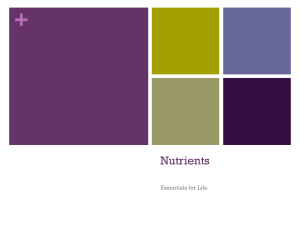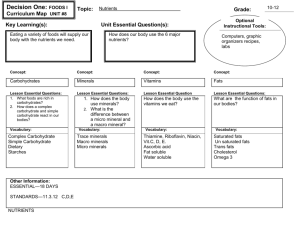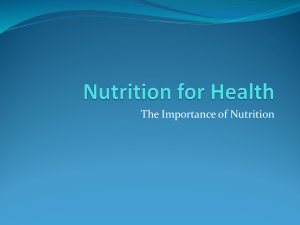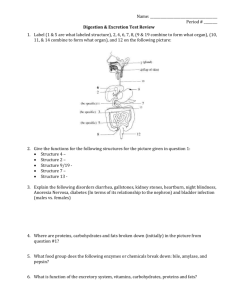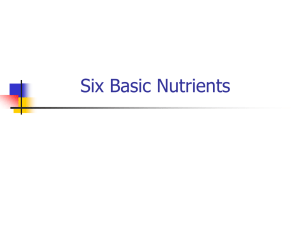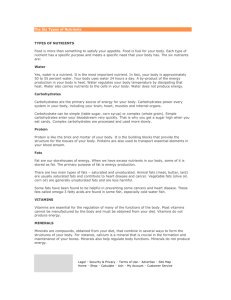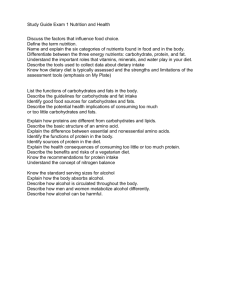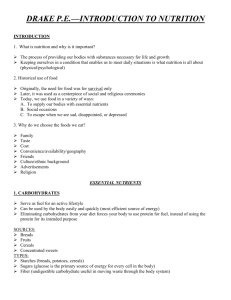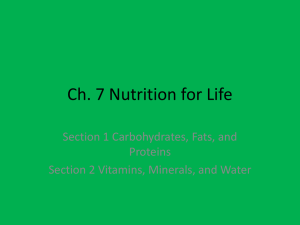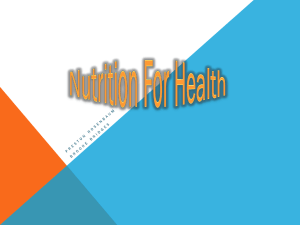Nutrition for Health Ch. 10
advertisement
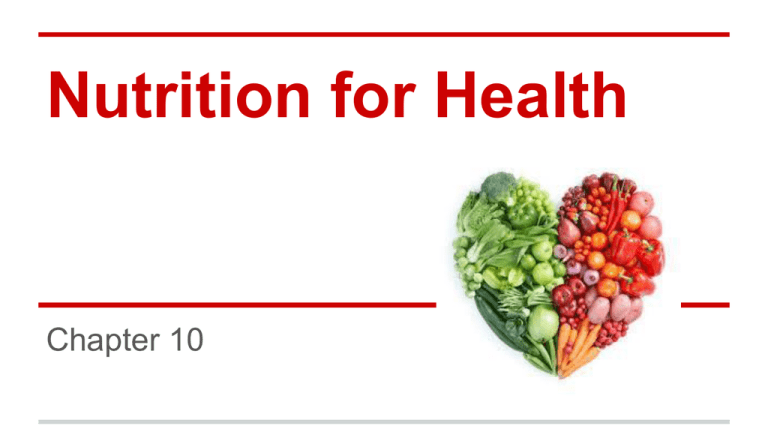
Nutrition for Health Chapter 10 The Importance of Nutrition ● Nutrition is the process by which your body takes in and uses food Nutrients are substances in food that your body needs to grow, to repair itself, and to supply energy o Calories are units of heat used to measure the energy your body uses and the energy it receives from food o Hunger vs. Appetite Hunger Appetite ● The natural physical drive to eat ● Prompted by the body’s need for food ● You may feel tired or lightheaded when you are hungry ● The psychological desire for food ● The smell of fresh cookies tempts you, even if you are full Food and the Environment How do the following influence what you eat? ● ● ● ● Family and Culture Friends Time and Money Advertising Giving Your Body What It Needs Everything you eat contains nutrients. Your body uses nutrients in many ways: ● As an energy source ● To heal, and build and repair tissue ● To sustain growth ● To help transport oxygen to cells ● To regulate body functions Giving Your Body What It Needs ● There are six types of nutrients: o o Carbohydrates, proteins, and fats provide energy Vitamins, minerals, and water perform a variety of other functions ● Getting a proper balance of nutrients during the teen years can improve your health through adulthood. Carbohydrates ● Carbohydrates are starches and sugars found in foods ● They act as the body’s main source of energy o Should be 45-65% of your daily calories ● There are three types of carbohydrates: o Simple, complex, and fiber Simple vs. Complex Carbohydrates Simple ● ● ● ● Mainly sugars Fructose - Found in fruits Lactose - Found in milk Found naturally, but are also added to many processed foods Complex ● Mainly starches ● Long chains of sugars linked together ● Grains, bread, pasta, beans, and root vegetables Fiber Fiber is a tough complex carbohydrate that the body cannot digest. ● Responsible for moving waste through the digestive system ● Helps you feel full, and may reduce the risks of cancer, heart disease, and Type 2 Diabetes ● 20 - 35 grams of fiber per day Proteins Proteins are nutrients the body uses to build and maintain its cells and tissues. They are made up of chemicals called amino acids. Types of Proteins Your body uses 20 amino acids found in foods o o 11 of these can be produced by the body and are called nonessential amino acids 9 of these are called essential amino acids and the body must get them from certain foods ● Other proteins come from animal sources o o Meat, eggs, dairy, and soy Called “complete” proteins because they contain all nine essential amino acids Roles of Proteins Protein is the basic building material of cells. The protein hemoglobin in red blood cells carries oxygen to all your body cells. Roughly 46 grams should be consumed per day, which is 10-15% of total daily calories. Fats Saturated Unsaturated ● Found mostly in animalbased foods ● Consuming too many saturated fats may increase the risk of heart disease ● Found in vegetable oils, nuts, and seeds ● Consuming in moderation may decrease the risk of heart disease Fats ● Trans fats are formed by a process called hydrogenation, causing vegetable oils to harden. o o As vegetable oil hardens, it becomes more saturated Found in stick margarine, snack foods, packaged baked goods ● Raise total blood cholesterol, increasing the risk of heart disease Bellwork 9/22/14 ● What are the six types of nutrients? ● Which three provide energy? ● Which is better for your body to consume, saturated fats, unsaturated fats, or trans fats? Vitamins vs. Minerals Vitamins ● Compounds that help regulate body processes ● Fat-soluble and water-soluble Minerals ● Elements in food that your body cannot produce Vitamins Water-Soluble ● Dissolve in water o Easily pass into the bloodstream ● Excreted through urine ● Not stored in the body so they must be replenished frequently Fat-Soluble ● Absorbed and transported by fat ● Stored in fatty tissue o Liver and kidneys ● Excess build-up can be damaging Water ● ● ● ● ● ● ● Moves food through the digestive system Digests carbohydrates and protein Aids chemical reactions in the body Transports nutrients and removes wastes Stores and releases heat Cools the body through perspiration Cushions the eyes, brain, and spinal cord What Should We Be Eating? The Dietary Guidelines for Americans are a set of recommendations about smart eating and physical activity for all Americans. Recommended Dietary Allowance (RDA) is the amount of nutrients that will prevent deficiencies and excesses in most people. MyPlate - The New Food Pyramid

